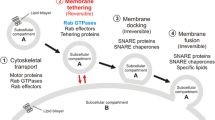Abstract
The possible correlation between plasma membrane fluidity changes induced by modified cultivation conditions and cell sensitivity to the killer toxin K1 ofSaccharomyces cerevisiae were investigated. Cells grown under standard conditions exhibited high toxin sensitivity. Both a membrane fluidity drop and fluidity rise brought about markedly reduced sensitivity to the toxin. These results do not fit the hypothesis of physiological relevance of direct toxin-lipid interaction, suggesting that the essential event in killer toxin action is interaction with membrane protein(s) that can be negatively influenced by any changes of membrane fluidity.
Similar content being viewed by others
Abbreviations
- DPH:
-
1,6-diphenyl-1,3,5-hexatriene
- PMF:
-
plasma membrane fluidity
- SSFA:
-
steady-state fluorescence anisotropy
References
Ahmed A., Sesti F., Ilan N., Shih T.M., Sturley S.L., Goldstein S.A.N.: A molecular target for viral killer toxin: TOK1 potassium channels.Cell99, 283–291 (1999).
Alexandre H., Mathieu B., Charpentier C.: Alteration in membrane fluidity and lipid composition, and modulation of H+-ATPase activity inSaccharomyces cerevistae caused by decanoic acid.Microbiology142, 469–475 (1996).
Assmann S., Sigler K., Höfer M.: Cd2+-induced damage to yeast plasma membrane and its alleviation by Zn2+: studies onSchizosaccharomyces pombe cells and reconstituted plasma membrane vesicles.Arch.Microbiol.165, 279–284 (1996).
Beaven M.J., Charpentier C., Rose A.H.: Production and tolerance of ethanol in relation to phospholipid fatty acid composition inSaccharomyces cerevisiae NCYC 431.J.Gen.Microbiol.128, 1447–1455 (1982).
Breinig F., Tipper D.J., Schmitt M.J.: KreIp, the plasma membrane receptor for the yeast K1 viral toxin.Cell108, 395–405 (2002).
Bussey H.: K1 killer toxin, a pore forming protein from yeast.Mol.Microbiol.5, 2339–2343 (1991).
Carmena M.J., Hueso C., Guijarro L.G., Prieto J.C.: Cholesterol modulation of membrane fluidity and VIP receptor effector system in rat prostatic epithelial-cells.Regulatory Peptides33, 287–297 (1991).
Flegelova H., Novotna D., Vojtiškova K., Janderová B.: Isolation and characterization ofSaccharomyces cerevisiae mutants with a different degree of resistance to killer toxins K1 and K2.FEMS Yeast Res.2, 73–79 (2002).
Hazel J.R., Williams E.E.: The role of alterations in membrane lipid composition in enabling physiological adaptation of organisms to their physical environment.Progr.Lipid Res.29, 167–227 (1990).
Heřman P., Konopásek I., Plášek J., Svobodova J.: Time-resolved polarized fluorescence studies of the temperature adaptation inBacillus subtilis using DPH and TMA-DPH fluorescent probes.Biochim.Biophys.Acta1190, 1–8 (1994).
Hlanik T., Lapútková G., Vondrejs V.: Current response of bilayer lipid membrane to killer factor fromSaccharomyces cerevisiae T158C.Gen.Physiol.Biophys.93, 93–95 (1984).
Hori T., Nakamura N., Okuyama H.: Possible involvement of acetylcoenzyme-A carboxylase as well as fatty acid synthetase in the temperature-controlled synthesis of fatty acids inSaccharomyces cerevisiae.J.Biochem.101, 949–956 (1987).
Howlet N.G., Avery S.V.: Relationship between cadmium sensitivity and degree of plasma membrane fatty acid unsaturation inSaccharomyces cerevisiae.Appl.Microbiol.Biotechnol.48, 539–545 (1997).
Ingram L.O., Butke T.: Effect of ethanol on microorganism.Adv.Microb.Physiol.25, 254–290 (1984).
Krasowska A., Chmielewska L., Gapa D., Prescha A., Vachova L., Sigler K.: Cell survival and formation of conjugated dienes in plasma membrane lipids ofSaccharomyces cerevisiae, Schizosaccharomyces pombe, Rhodotorula glutinis andCandida albicans exposed to hydrophilic, amphiphilic and hydrophobic pro-oxidants.Folia Microbiol.47, 145–151 (2002).
Lakowicz J.R.:Principles of Fluorescence Spectroscopy, 2nd ed., pp. 321–333. Kluwer Academic-Plenum Publishers, New York 1999.
Ma Z.H., Meddings J.B., Lee S.S.: Membrane physical-properties determined cardiac β-adrenergic-receptor function in cirrhotic rats.Am.J.Physiol.267, G87-G93 (1994).
Magliani W., Conti S., Gerloni M., Bertolotti D., Polonelli L.: Yeast killer systems.Clin.Microbiol.Rev.10, 369–400 (1997).
Martinac B., Zhu H., Kubalski A., Zhou X., Culbertson M., Bussey H., Kung C.: Yeast K1 killer toxin forms ion channels in sensitive yeast spheroplasts and in artificial liposomes.Proc.Nat.Acad.Sci.USA87, 6228–6232 (1990).
de la Peña P., Barros F., Gascon S., Ramos S., Lazo P.S.: Primary effects of yeast killer toxin.Biochem.Biophys.Res.Commun.96, 544–550 (1980).
de la Peña P., Barros F., Gascon S., Lazo P.S., Ramos S.: Effect of yeast killer toxin on sensitive cells ofSaccharomyces cerevisiae.J.Biol.Chem.256, 10420–10425 (1981).
Shinitzky M., Barenholz Y.: Fluidity parameters of lipid regions determined by fluorescence polarization.Biochim.Biophys.Acta515, 367–394 (1978).
Sinigaglia M., Gardini F., Guerzoni M.E.: Relationship between thermal behavior, fermentation performance and fatty acid composition in two strains ofSaccharomyces cerevisiae, Appl.Microbiol.Biotechnol.39, 593–598 (1993).
Tomita T., Watanabe M., Yasuda T.: Influence of membrane fluidity on the assembly ofStaphylococcus aureus α-toxin, a channel-forming protein, in liposome membrane.J.Biol.Chem.267, 13391–13397 (1992).
Vondrejs V., Pšenička I., Kupcová L., Dostálová R., Janderová B., Bendová O.: The use of a killer factor in the selection of hybrid yeast strains.Folia Biol.29, 372–384 (1983).
Author information
Authors and Affiliations
Corresponding author
Rights and permissions
About this article
Cite this article
Flegelová, H., Chaloupka, R., Novotná, D. et al. Changes in plasma membrane fluidity lower the sensitivity ofS. cerevisiae to killer toxin K1. Folia Microbiol 48, 761–766 (2003). https://doi.org/10.1007/BF02931510
Received:
Revised:
Issue Date:
DOI: https://doi.org/10.1007/BF02931510




